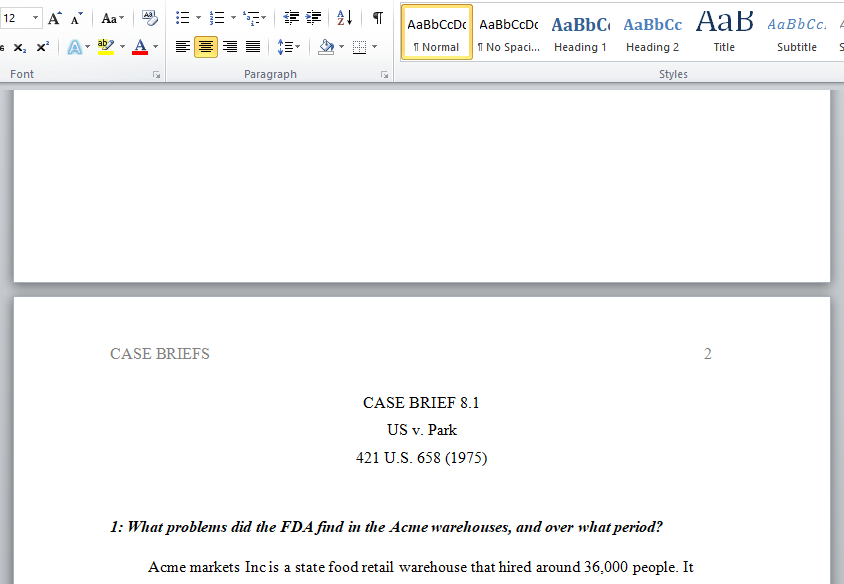Answer the following question on the two case briefs provided
CASE BRIEF 8.1
United States v. Park
421 U.S. 658 (1975)
FACTS: John R. Park was president of Acme Markets, Inc., a national food chain headquartered in Philadelphia with 36,000 employees and 16 warehouses.
In 1970, the FDA found problems with rodent infestation at Acme’s Philadelphia warehouse facility. In 1971, the FDA found the same conditions in Acme’s Baltimore warehouse. In 1972, the FDA’s chief of compliance wrote to Park and asked that he direct his attention to the prolonged problems of warehouse infestation. The FDA inspected the Baltimore warehouse two months after Park was sent the letter and found the same problems. Acme and Park were both charged with violations of the Pure Food and Drug Act.
DECISION BELOW: Park was convicted and fined $500. The Court of Appeals reversed.
ISSUE ON APPEAL: Was Park liable for the warehouse problems when subordinates had been ordered to remedy the situation?
DECISION: Yes. He was aware of the deficiencies in his subordinates’ system and still took no action.
Questions:
1. What problems did the FDA find in the Acme warehouses, and over what period?
2. Was Mr. Park warned about the problem? What action did he take?
3. What standard of liability did the instruction given by the judge impose?
CASE BRIEF 9.3
Van Horn v. Watson
197 F.3d 164 (Cal. 2008)
FACTS: On October 31, 2004, Alexandra Van Horn (plaintiff), Jonelle Freed, and Lisa Torti smoked and inhaled marijuana together at Ms. Torti’s home. They were joined there by Anthony Glen Watson and Dion Ofoegbu, who also joined in on the marijuana. At 10:00 PM, they all headed to a local bar where they drank until 1:30 AM. At 1:30 AM, Ms. Van Horn and Ms. Freed left with Mr. Watson, leaving Ms. Torti to ride with Mr. Ofoegbu. Mr. Watson struck a curb and then a light pole whilst going 45 mph. After Mr. Watson crashed, both Mr. Ofoegbu and Ms. Torti stopped and got out of their car to render aid. Mr. Watson got out of the car by himself, Mr. Ofoegbu helped Ms. Freed out by opening a door for her, and Ms. Torti pulled Ms. Van Horn from the car. Ms. Van Horn said Ms. Torti pulled on her arm and dragged her from the car like a “rag doll.”
Ms. Torti testified that the crashed car was smoking and that she felt she should save Ms. Van Horn before flames ensued. Emergency personnel arrived moments later. Ms. Van Horn had a lacerated liver and damaged vertebrae that rendered Ms. Van Horn paraplegic. Ms. Van Horn filed suit claiming that Ms. Torti’s pulling her from the wreck contributed to her paralysis. Ms. Van Horn also filed suit against all other party animals riding along in the two vehicles for their negligence. Ms. Torti claimed immunity under California’s Good Samaritan statute.
Ms. Van Horn alleged that Ms. Torti was negligent in pulling her from the car and not waiting for trained personnel. There were differing accounts on whether the car was smoking and if there were flames. In other words, the danger to Van Horn was not clear. In fact, given the evening’s activities, not a one of them was operating in anything less than a fog at the time of the accident.
LOWER COURT DECISIONS: The trial court granted summary judgment for Ms. Torti on the grounds that she enjoyed immunity from suit for negligence under the California Good Samaritan law. The Court of Appeal reversed, holding that the Good Samaritan law applied only to those rendering medical care, and that Torti had not provided medical care. Ms. Torti and the others appealed.
ISSUE ON APPEAL: Are those who render assistance, not necessarily medical assistance, at the scene of an accident protected by statutory immunity under the Good Samaritan law?
DECISION: No. The court held that the statute in California did not provide immunity for those who simply render assistance. The court focused on the statutory language and history and concluded that the protection was intended to be limited to providing medical care. The court also held that the effect would be to immunize everyone and undermine the common-law rule that no one has to help, that is, there is no duty to help and those who do so render help at the risk of liability.
Questions:
1. What is the relationship between statutory immunity and common law duty here?
2. Would it have been better for Ms. Torti to argue that she was providing medical treatment and have the court deal with the issue of what constitutes medical care rather than the issue of immunity?
3. What are the implications of this decision for people who are trying to offer assistance at the scene of an accident?
Answer preview :

Word limit : 1410
